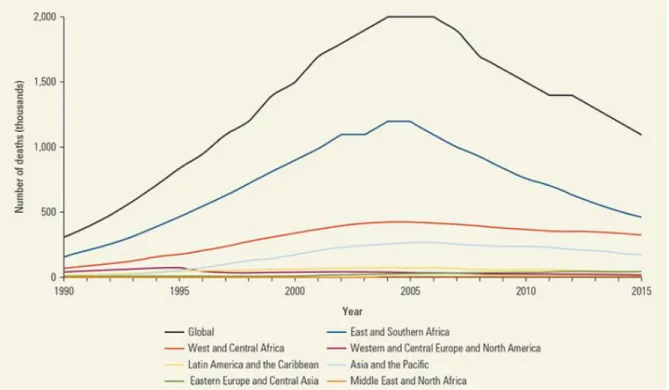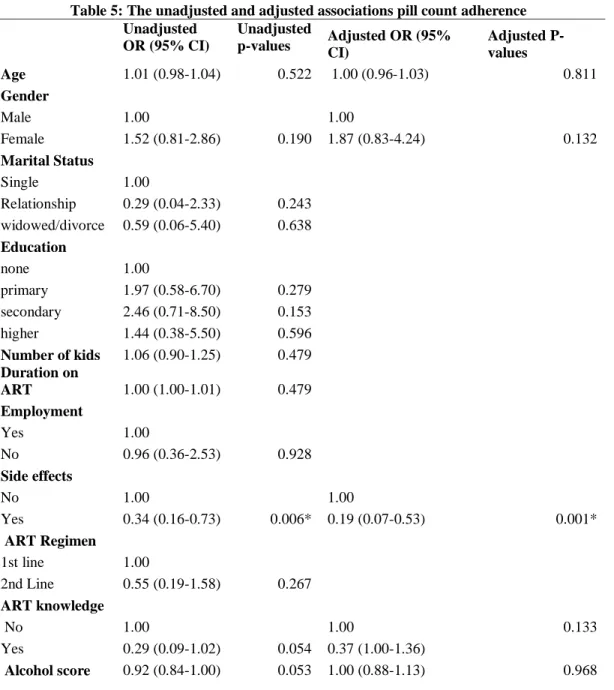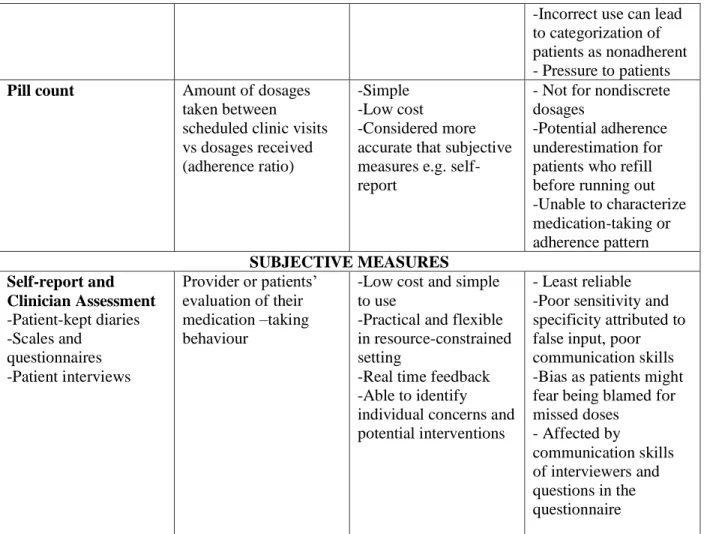The aim of this study was to examine the association between depression, anxiety and alcohol use disorder symptoms and ART adherence among people living with HIV/AIDS (PLWHA) attending an HIV clinic in Blantyre, Malawi. ART adherence was assessed by pill count, a self-report measure, and a combined measure of pill count and self-report adherence.
INTRODUCTION
B ACKGROUND
Other mental health problems that have been shown to be associated with suboptimal ART adherence include psychological distress and neurocognitive impairments (Nakimuli-Mpungu et al., 2012; Nyamayaro et al., 2020). A few studies conducted in Malawi focused only on depressive symptoms (Stockton et al., 2021; Spielman et al., 2021).
AIM & OBJECTIVES
- Aim
- Objectives
Currently, very few studies have been conducted in Malawi specifically examining the association between mental health problems and ART adherence. A few studies conducted in Malawi focused only on depressive symptoms (Stockton et al., 2021;.
LITERATURE REVIEW
- H UMAN I MMUNODEFICIENCY V IRUS
- G LOBAL B URDEN OF HIV
- HIV/AIDS IN M ALAWI
- G LOBAL RESPONSE AND 90:90:90 TARGETS
- A SOCIAL - ECOLOGICAL APPROACH TO ART ADHERENCE
- B ARRIERS TO ART A DHERENCE
- Structural and Health Service Factors
- Social factors
- Individual factors
- M ENTAL H EALTH AMONG PLWHA
- Depression and ART adherence
- Alcohol Use Disorder (AUD) and ART Adherence
- Anxiety disorder and ART adherence
- Rationale
A study by Kim et al. 2016) examines barriers to ART adherence among mothers on Option B+ (lifelong ART treatment for pregnant and lactating women). Having HIV-associated neurological disorders has also been associated with lower adherence to ART (Ettenhofer et al., 2010). A recent meta-analysis examined the association between anxiety and adherence in the low-paid population (Wykowski et al., 2019).

METHODOLOGY
- T YPE OF S TUDY
- S TUDY S ETTING AND S TUDY P OPULATION
- D EFINITIONS AND E LIGIBILITY
- M EASURES
- ART adherence
- Depression (PHQ-9)
- Alcohol use disorder (AUDIT)
- Anxiety (GAD-7)
- Social support (MSPSS)
- Clinical characteristics and knowledge
- S TUDY P ROCEDURES
- S CREENING R EPORT
- S AMPLE S IZE
- Statistical Analysis
- E THICAL C ONSIDERATIONS
- Voluntary Informed Consent
- Confidentiality
- Potential Risks to Participants
- Potential Benefit to Individual Participants and Value to the Host Country
- Adverse Event Reporting
- Data and Safety Monitoring Plan
- Data Sharing Plan
- Reimbursements
Two dedicated nurses were recruited by the candidate as research assistants to screen, recruit and administer the research questionnaire at the ART clinic. After routine clinical consultations, the physician referred the patients to the study nurses for further information about the study. Patients willing to participate in the study were asked to sign a written informed consent form.
The candidate then reviewed the questionnaires to ensure that all queries were resolved by the study nurses. During the study period (June–August 2018), clinic staff referred 226 patients out of 1,651 examined patients to research staff. Three patients refused to participate in the study, and 215 patients gave consent and were included.
The study protocol was approved by the University of Cape Town Human Research Ethics Committee (HREC 121/2018) and the Malawi National Health and Scientific Research Board (NHSRC See Appendix). Individuals were provided with information on how to contact study staff to report study-related adverse events.
RESULTS
- P ARTICIPANT C HARACTERISTICS
- S ELF -R EPORT A DHERENCE
- P ILL C OUNT A DHERENCE
- C OMBINED ADHERENCE ( SELF - REPORT AND P ILL C OUNT )
Participants who scored higher on the AUDIT were less likely to adhere to ART treatment. The univariate logistic regression showed that only having side effects was significantly associated with pill count adherence. Participants who experienced one or more side effects from treatment were less likely to be adherent than participants who reported no side effects (OR=0.34; 95%).
Only side effects remained significantly associated with pill count adherence after adjustment for age, gender, side effects, ART knowledge and alcohol use (OR=0.19; 95% CI p-value=0.001). For combined adherence, side effects and alcohol use were significantly associated with combined adherence in the crude regression. Participants who experienced one or more side effects from treatment were less likely to be adherent.
Participants who scored higher on the AUDIT were also less likely to adhere to treatment. After further modeling with age, sex, side effects and alcohol consumption, only the experienced side effects remained significantly associated with combined adherence (OR=0.45; 95% CI p-value=0.011).

DISCUSSION
- Prevalence of Mental Disorder Symptoms
- ART Adherence Prevalence
- Association between depression, anxiety and alcohol use disorder symptoms and ART adherence
However, there was no significant association between depression and anxiety and adherence across all three adherence measures. There was a significant association between alcohol consumption and adherence, with those who scored higher on the AUDIT being less likely to adhere (OR=0.84, p-value=0.018). Similarly, alcohol consumption was also significantly associated with combined adherence, with those participants who scored higher on the AUDIT being more likely to not follow treatment (OR=0.85, p-value=0.026).
In addition to mental health variables, there were other factors associated with ART adherence that showed statistical significance. Participant age was significantly associated with self-reported adherence, with older participants being more likely to be adherent than younger participants (OR=1.03, p-value=0.050). Treatment side effects experienced by the participants were also significantly associated with both the number of pills and the combined adherence measures, with those who experienced at least one side effect being less likely to be adherent (OR=0.34; .p-value=0.006 and OR =0.51, p-value=0.027 respectively).
According to the socio-ecological framework, the variables included in this thesis centered on the relationship between the personal and social factors and ART adherence. The results show that, according to the framework, only a few individual factors (age, alcohol and side effects) had a significant association with ART adherence.
R ELATIONSHIP OF KEY FINDINGS WITH LITERATURE
- Adherence Assessment Methods
- Prevalence of Common Mental Health Problems among PLWHA
- Association between mental health disorder symptoms and ART adherence
This is similar to a cross-sectional study by Magidson et al. 2017), which examined the prevalence of alcohol consumption among ART clinic attendees in South Africa. However, self-reported alcohol consumption is sensitive to social desirability and the amount of alcohol consumed is often underreported (Adong et al., 2019). We suspect this may have been the case in the current study, although population studies in Malawi have shown that overall alcohol consumption is relatively low, with women drinking much less than men (Mwangomba et al., 2018).
In a number of studies, depressive symptoms have been found to be significantly associated with ART nonadherence (Uthman et al., 2014; Wagner et al., 2017; Wagner et al., 2011). A recently published Malawian paper examined six-month post-ART initiation viral suppression outcomes between patients with depressive symptoms and no depressive symptoms (Stockton et al., 2021). In a longitudinal study, Kahler et al. 2017) examined direct (viral load and CD4 count) and indirect (renal impairment and liver fibrosis) effects of alcohol use among HIV patients on ART medication with a follow-up period of six months.
In a meta-analysis of 21 studies, Scott-Sheldon et al., (2017) evaluated the efficacy of behavioral interventions to reduce alcohol use among PLWHA. This is also consistent with other studies that have shown that experiencing side effects from ART is associated with ART nonadherence (Cauldbeck et al., 2009;
S TUDY L IMITATIONS
A systematic review and meta-analysis of 19 studies examining the impact of treatment-related adverse events (AEs) on ART adherence showed that specific AEs such as fatigue, taste disturbance, and nausea were significantly associated with poor adherence (Al- Dakkak et al., 2013). Similarly, a qualitative study in Lilongwe, Malawi that examined barriers and facilitators to ART adherence among pregnant women found that most women cited side effects as the main reason for not adhering to ART (Kim et al., 2016). This is also consistent with a meta-analysis of 20 studies, which reported that older individuals with HIV are at a significantly reduced risk of non-adherence compared to younger PLWHA at both short- and long-term assessments (Ghidei et al., 2013).
Similarly, another meta-analysis of 20 African studies comparing adherence between older and younger PLWHA found that a greater proportion of older patients were adherent to ART compared to younger patients in the studies using objective measures (medication possession ratio and clinic score) (OR CI) Soomro et al., 2019) Consistent with the current study, a cohort study of pregnant and lactating women who initiated ART at 13 Pagan facilities in Malawi found that ART initiation at a younger age was a risk factor for non-adherence (Haas et al., 2016). This poses a challenge in establishing the temporality of common mental disorder symptoms and ART adherence compared to other longitudinal study designs. Finally, the current study did not examine the mediating effects of other non-mental health factors such as knowledge and social support in the relationship between mental disorder symptoms and ART adherence.
First, this is the first paper in Malawi to simultaneously assess three mental health issues in relation to ART therapy. Second, the study used three measures of adherence: self-report, number of pills, and a combination of them, which balanced both the subjective and objective approach to assessing adherence.
R ECOMMENDATIONS FOR FUTURE RESEARCH AND PRACTICE
For example, in Zimbabwe, training nurses, community health workers and traditional medicine practitioners to screen for harmful alcohol and drug use was found to be feasible and acceptable (Duffy et al., 2017). Again in Zimbabwe, a problem-solving intervention for depression delivered by lay adherence counselors was found acceptable by patients and led to improvement in depression symptoms and ART adherence (Nyamayaro et al., 2020). Studies conducted in Cameroon and Uganda have shown promising findings on the feasibility and effectiveness of integrating depression treatment and HIV care (Pence et al., 2014; Nakimuli-Mpungu et al., 2015).
In Malawi, a quasi-experimental pilot study was conducted to evaluate the effectiveness of integrating depression treatment into routine HIV care (Udedi et al., 2019). For example, the Friendship Bench program in Zimbabwe has been successful and proven feasible, where lay health workers provide mental health interventions (Chibanda et al., 2016). Approaches such as text messaging and mobile phone applications have shown promising effectiveness, feasibility, and acceptability in improving adherence among youth living with HIV/AIDS (Badawy et al., 2017).
Interventions for coping skills and self-management of HIV treatment adverse events should be explored as some studies have shown that such interventions are effective in reducing non-adherence to treatment (Johnson et al., 2011). Future research should also expand to include structural and health factors that have been shown to impact ART adherence (Musheke et al., 2012).
C ONCLUSION
Psychiatric disorders and treatment adherence in a population of HIV-infected adults in Nigeria. Factors influencing adherence to antiretroviral therapy among pregnant women in the Eastern Cape, South Africa. The impact of specific HIV treatment-related adverse events on adherence: a systematic review and meta-analysis.
Adherence to antiretroviral therapy in patients receiving free treatment from a government hospital in Blantyre, Malawi. Anxiety and depression symptoms as risk factors for non-adherence to antiretroviral therapy in Brazil. The effect of disclosure on adherence among adults living with HIV in Ethiopia: a systematic review and meta-analysis.
Alcohol consumption and nonadherence to antiretroviral therapy among HIV-infected patients in West Africa. Alcohol consumption and nonadherence to antiretroviral therapy among HIV-infected patients in West Africa. Association between depression and adherence to antiretroviral therapy in HIV-positive patients, KwaZulu-Natal, South Africa.
Depression and adherence to antiretroviral therapy in low-, middle-, and high-income countries: A systematic review and meta-analysis.

